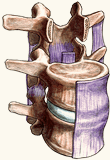Diagnosis of Cervical Radiculopathy
Cervical radiculopathy or “pinched nerve” describes irritation or compression of one of the spinal nerves in the neck. Radiculopathy is a medical term used to indicate a problem affecting the nerve root. Symptoms usually occur in the region supplied by the nerve, i.e., the shoulder, arm or hand and include pain, numbness, tingling, or weakness. Cervical radiculopathy can also cause neck pain and headaches in the back of the head. The condition tends to occur in middle-aged or elderly individuals and is often caused by a herniated disc or degenerative changes to spinal structures. MRI is the best way to diagnose whether or not a herniated disc or bone spur is causing nerve compression.
Conservative Treatment of Cervical Radiculopathy
Although painful, cervical radiculopathy rarely causes permanent damage. Many times, the condition will resolve without treatment. Medication and physical therapy are often successful in alleviating symptoms. In cases of persistent pain, steroid injections e.g., epidural injections or nerve blocks, may be prescribed.
Cervical Radiculopathy Surgery
Surgery may be recommended if conservative treatment fails, pain is severe, or if weakness progresses or worsens. For patients presenting with neck pain alone, and/or a significant amount of neck pain compared to arm pain, surgery is usually not beneficial. Only your surgeon can determine if you are a good candidate for surgery and you should discuss the range of possible outcomes with him/her before making a treatment decision.
Anterior Cervical Discectomy and Fusion (ACDF)
Cervical radiculopathy can be treated utilizing an anterior (front of the neck) or posterior (back of the neck) approach. The anterior approach is often called an Anterior Cervical Discectomy and Fusion or ACDF. The procedure involves removing the entire disc in order to gain access to the nerves and spinal cord. Following that, a spacer – made of bone, a special plastic, or metal – is placed into the space where the disc used to be. Following that, an metal plate is placed in the very front of the vertebrae to lock everything in place.
Posterior Cervical Foraminotomy (PCF)
The other option is approaching the nerves from the back of the neck. It is called a posterior cervical foraminotomy (PCF). This is a minimally invasive procedure. PCF involves removing bone spur in order to make more room for the compressed nerve root. If the disc can be reached and removed this is done also. I do this procedure as a same day surgery, i.e. outpatient




 Dr. Kwon specializes in treating adult spine disorders. Whether you’re suffering from neck or back pain, Dr. Kwon will provide you with all the information you need to make an informed treatment decision.
Dr. Kwon specializes in treating adult spine disorders. Whether you’re suffering from neck or back pain, Dr. Kwon will provide you with all the information you need to make an informed treatment decision.